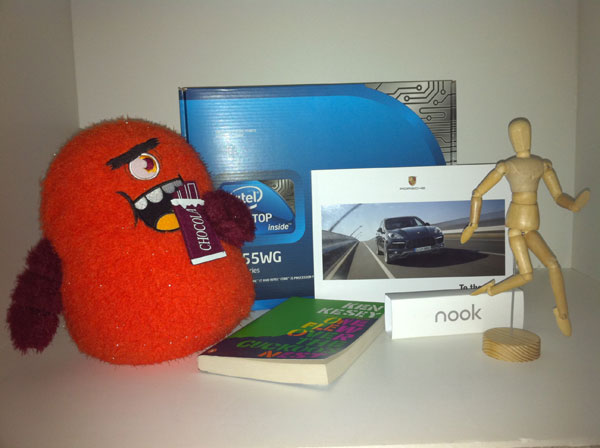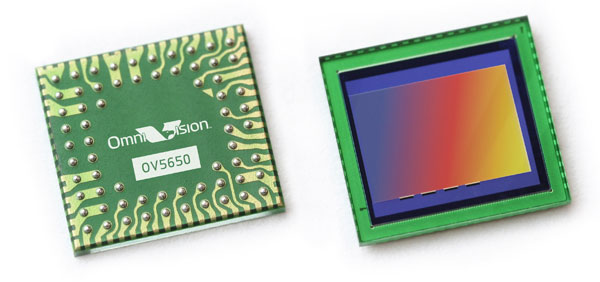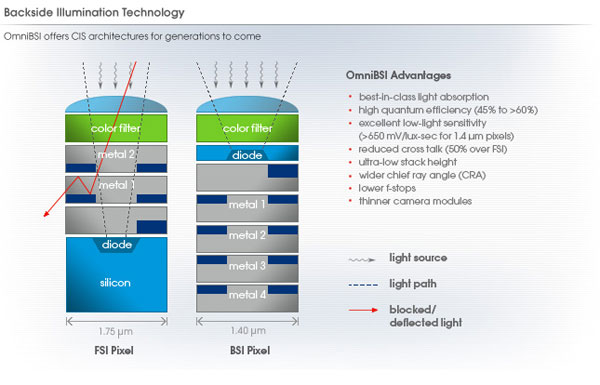Apple's iPhone 4: Thoroughly Reviewed
by Brian Klug & Anand Lal Shimpi on June 30, 2010 4:06 AM EST- Posted in
- Smartphones
- Apple
- iPhone 4
- Gadgets
- Mobile
Welcome to 2010, Apple Upgrades its Camera
The iPhone 4 is equipped with two cameras: a 5 megapixel camera with LED flash on the back of the phone and a VGA camera with no flash on the front. The LED flash works in both still and video modes. Like the EVO 4G, the iPhone 4‘s flash allows you to shoot in perfect darkness. If you’re filming a video in low light the LED will stay illuminated while you’re recording.

Taken with the iPhone 4 in total darkness
The same unfortunately can’t be said for the front facing camera on the 4. In anything but good lighting you’re going to get noise. It’s really only useful for FaceTime (or as an alternative to a mirror) and even then you need to be well lit for it to look decent.
Apple has opted for a 5 megapixel OmniVision sensor for the rear camera on the iPhone 4. What's interesting is that Apple has decided to bring backside illumination front and center with their marketing.
Backside illumination improves the sensitivity of CMOS and CCD detectors by reducing the amount of material in the path of incident light. In a frontside illuminated detector, a considerable amount of light is lost due to absorption that doesn't result in emission of an electron, in addition to reflection off pixel structures and electrical components near the frontside surface. Backside illumination greatly improves sensitivity by flipping the stack over. Instead of light having to pass through and possibly be reflected by metal structures, it is converted into electrons and read out by passing solely through silicon. Creating a backside illuminated part isn't as simple as flipping a sensor over, however, as manufacturers also generally thin the silicon light has to pass through before it can reach the photodiode. This further improves sensitivity and is generally accomplished through chemical etching in acid or by lapping (physically grinding) sensors at wafer scale.

OmniVision OV5650 - iPhone 4's rear camera SoC
Though backside illumination (BSI) improves quantum efficiency (how many photons are converted into electons), backside illumination is hugely important for another serious reason as well. Because the sensor is small at 4.6 mm by 3.4 mm, pixel size is also extremely small at just 1.75 microns square for the OV5650 in the iPhone 4 (state of the art sensors are 1.4 microns square, like those in the HTC Incredible's 8 MP sensor). Frontside illuminated parts generally have in the neighborhood of 10-15 microns of silicon before the active region of the photodiode where one wants photons to get converted to electrons. The result is that without backside illumination, pixels have a 10:1 ratio of height to length, you can visualize them as looking something like long square pillars. But that's a problem.
As photons are converted into electrons in that silicon, there's no guarantee that it will immediately travel down into the gate structure below to be read out by the camera. Electrons drift as they descend these columns, meaning that photons incident on one pixel don't necessarily map to the gate below. Because the smartphone camera sensors are so small, with a 10:1 ratio of height to size, the result is large amounts of so-called quantum blurring from electrons traveling into the gate structures of adjacent pixels. The result is a blurry image (and a decrease in MTF at the sensor level!), thus not representing the image that used to be incident on the sensor.
OmniVision and other smartphone CMOS sensor manufacturers thin that column down in an effort to come closer to having the pixel look more like a cube than a huge pillar. Ballpark numbers are between 3 and 6 microns, down from 10-15. The result is much more sensitive sensors that are higher resolution. While megapixels don't necessarily matter, neither does pixel size as much anymore; it's all about quantum efficiency, which is what engineers really care about.

OmniVision BSI - Courtesy OmniVision
The optical system of the iPhone 4 is difficult to characterize without disassembly, though the focal length is a bit shorter than previous iPhones. The result is that the photos are demonstrably wider angle. Backside illumination also allows for a bigger chief ray angle, higher numerical aperture (and thus lower f/#), but I won't bore you with the details.










270 Comments
View All Comments
strikeback03 - Tuesday, July 6, 2010 - link
I would assume they were referring to the launch of Windows Phone 7, which may prove to be a viable smartphone competitor. But being still months away that is a long time for competitors to move ahead.Also, as far as hardware goes, there are phones built with modern hardware, such as the HTC HD2. The software is the real problem.
softdrinkviking - Sunday, July 4, 2010 - link
the biggest turn off for me is still the lack of micro SD support.i use my phone as my primary mp3 player, and i end up filling up 16GB really quickly.
with SD cards, you can swap out your storage on the go, rather than having to return home and do a sync in itunes.
also, itunes is awful. it's such a pain in the ass to use, and i can think of no good reason that we can't drag and drop mp3 files onto our phones, or better yet, onto SD cards. (other than the fact that apple wants to force you to go through their online marketplace on a regular basis)
D3lta - Sunday, July 4, 2010 - link
By far the best review I've ever read. Thanks and keep up the good work.avoidz - Sunday, July 4, 2010 - link
Cynical maybe, but I'm sure this was all part of the plan, knowing that users would require the $30 bumper case.Consolidated - Sunday, July 4, 2010 - link
A rough (eyeball) estimate of your diagram finds the umts antenna to be about twice as long as the WiFi antenna. Connecting the two would increase the length of the umts antenna about 50%, midway between the base length and the first harmonic length. Nasty VSWR there.The same calculus INCREASES the wifi antenna length by a factor of three, just about the second harmonic (an odd harmonic, yes but way better than midway between, no?).
zero01 - Sunday, July 4, 2010 - link
This is a must have, I hear it fixes everythingVery funny although I cant see them selling many.
docflash - Sunday, July 4, 2010 - link
as a physician, i've had lots of patients who've had allergies to metal - nickel in particular. an effective fix is coating the metal, often in a ring or other piece of jewelry, with a couple of layers of clear nail polish. this doesn't allow their skin to touch the metal, and stops the allergy.it's *possible* that some clear nail polish would have the same effect on the metal of the iP4's antenna. now, i am not an engineer (nor do i play one on TV) but i see no reason this won't work. and if it does: well, i'm in the market for a new phone, and the iP4 could be it.
if it *does* work for you, great! but share the news - i'd like to try it myself (and so might other folks).
scubasteve03 - Monday, July 5, 2010 - link
I have searched everywhere! Where can I find that the background on the home screen in the " The Real Story on iPhone 4's Antenna" section? It has the vertical stripes that is yellow and black. If anyone could please help me figure out where to get send me an email. First person to find it for me gets 10 internet points! selphs03@gmail Thanks everyone!Romion - Monday, July 5, 2010 - link
First of all, regarding battery life I dont think that the real talk time is bigger than what Apple announced (about 7h). I know from experience that all my phones till now had talk times around 1/2 up to 2/3 of what manufacturer announced (the talk time announced is IDEAL, most probably non existent in real life.) Just curios, how did u check the talk time?BUT, MAYBE THIS IS A MAGICAL DEVICE AND I AM ALL WRONG.
Anand, if u use some technical data this doesnt mean that they are correct/ true and we can rely on this review.
U said that u were in line at mall for every Iphone model till now, well, that tell us/me everything.
Sorry if my english is not perfect, im not a native english speaker, but a smart enough guy to see things how they are in reality and not listen to others in their bias reviews.
gl
Stoli89 - Monday, July 5, 2010 - link
It would be interesting to understand if changes to the WiFi/Bluetooth/GPS portion of the antenna system has an impact on the 2G/3G portion. If energy from wifi and/or bluetooth and/or GPS is causing interference with the 2G/3G signal processing when the so-called "gap" is conductively bridged. Current test seem to focus on the 2G/3G antenna being de-tuned when the external antenna gap is bridged, without considering if energy is also leaking through and corrupting the 2G or 3G signal(s). Just curious if this is just one more parameter which has confused the outcomes for different customers.